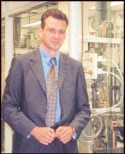Water-Blown EPS Will Help You and the Environment
The world’s first water-blown expandable polystyrene bead (WEPS) is in development at Nova Chemicals’ new technology center in Breda, the Netherlands.
The world’s first water-blown expandable polystyrene bead (WEPS) is in development at Nova Chemicals’ new technology center in Breda, the Netherlands. WEPS will mimic conventional EPS but will contain 5-10% by weight of micron-sized water droplets instead of pentane as a blowing agent.
Early research on WEPS was funded at universities in Belgium and Holland by Shell Chemical Co. Nova acquired the WEPS technology and patents when it bought Shell’s PS business in 2000. The patented process to make WEPS involves creating a molecular bond between cornstarch and styrene monomer using a compatibilizer such as maleic anhydride. Nova encapsulates the starch in a shell of PS. The starch absorbs a small amount of water during aqueous polymerization.
WEPS would help processors meet ever-stricter environmental regulations without the capital cost of pollution controls. Another big ad van tage is that WEPS avoids the long aging time required for pentane-blown EPS beads, which must be aged at least 4 to 12 hr after pre-expansion (and often as long as a day or two) before they can be molded. The shortest aging time for EPS is 3 to 4 hr, but that’s possible only with special low-pentane PS formulations.
Pentane softens PS like a plasticizer, aiding expansion. But after expansion, the pentane leaves soft bubbles with a slight vacuum inside. They have to refill gradually with ambient air before the EPS beads are strong enough to be shaped into a part.
Water doesn’t plasticize PS, so water-blown beads don’t soften and are usable right out of the pre-expander. By the same token, water-blown beads need extra help during pre-expansion, so Nova applies a slight vacuum in the pre-expander, which causes the air pressure inside the bead to add expansion force. If normal pentane-blown EPS parts have to be precise in size, they may need to be stored again after shape molding—sometimes for weeks—to shrink before shipping. WEPS parts do not.
Different pre-expanders
WEPS may be as much as a year away from its first processor trials. WEPS is being designed to run on existing EPS shape-molding machines. WEPS will, however, require changes in the pre-expander. Nova is working with several machine builders under secrecy agreements.
Pre-expanders for WEPS will need to withstand higher temperatures and pressures, so thermocouples and pressure gauges must be added. WEPS is pre-expanded at 248 to 266 F, vs. 212 to 239 F for conventional pentane-blown EPS. Applying higher pressure to WEPS pre-expansion raises temperatures. For example, water at 4 bars (58 psi) of pressure reaches 302 F and makes lower-density EPS, says Nova’s Dr. Michel Berghmans, team leader for EPS research at Breda.
Other pre-expansion heating methods may even tually prove more efficient. Michel Berghmans’ father, Dr. Hugo Berghmans, a professor at the Catholic University of Leuven in Belgium, has performed R&D on heating with a high-frequency electric field instead of steam. Microwave energy heats the water droplets inside the plastic, not the plastic itself. Heat then transfers from the boiling water to the PS, which expands as it reaches its glass-transition temperature.
On the other hand, application of steam in a pre-expander heats the polymer first, then transfers from the polymer to the water. This takes longer and loses water vapor in the process. Overheated foam also takes longer to cool, allowing bubbles to partially collapse during cooling.
Although WEPS requires more energy for pre-expansion than standard EPS, WEPS reportedly takes much less energy (and time) for shape molding. That’s because WEPS requires less cooling in the shape mold after fusion, since the beads are not softened by pentane.
Read Next
Why (and What) You Need to Dry
Other than polyolefins, almost every other polymer exhibits some level of polarity and therefore can absorb a certain amount of moisture from the atmosphere. Here’s a look at some of these materials, and what needs to be done to dry them.
Read MoreUnderstanding Melting in Single-Screw Extruders
You can better visualize the melting process by “flipping” the observation point so that the barrel appears to be turning clockwise around a stationary screw.
Read MoreLead the Conversation, Change the Conversation
Coverage of single-use plastics can be both misleading and demoralizing. Here are 10 tips for changing the perception of the plastics industry at your company and in your community.
Read More

















.png;maxWidth=300;quality=90)





